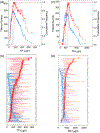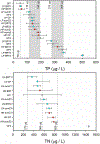Developing Indicators of Nutrient Pollution in Streams Using 16S rRNA Gene Metabarcoding of Periphyton-Associated Bacteria
- PMID: 36213613
- PMCID: PMC9534034
- DOI: 10.3390/w14152361
Developing Indicators of Nutrient Pollution in Streams Using 16S rRNA Gene Metabarcoding of Periphyton-Associated Bacteria
Abstract
Indicators based on nutrient-biota relationships in streams can inform water quality restoration and protection programs. Bacterial assemblages could be particularly useful indicators of nutrient effects because they are species-rich, important contributors to ecosystem processes in streams, and responsive to rapidly changing conditions. Here, we sampled 25 streams weekly (12-14 times each) and used 16S rRNA gene metabarcoding of periphyton-associated bacteria to quantify the effects of total phosphorus (TP) and total nitrogen (TN). Threshold indicator taxa analysis identified assemblage-level changes and amplicon sequence variants (ASVs) that increased or decreased with increasing TP and TN concentrations (i.e., low P, high P, low N, and high N ASVs). Boosted regression trees confirmed that relative abundances of gene sequence reads for these four indicator groups were associated with nutrient concentrations. Gradient forest analysis complemented these results by using multiple predictors and random forest models for each ASV to identify portions of TP and TN gradients at which the greatest changes in assemblage structure occurred. Synthesized statistical results showed bacterial assemblage structure began changing at 24 μg TP/L with the greatest changes occurring from 110 to 195 μg/L. Changes in the bacterial assemblages associated with TN gradually occurred from 275 to 855 μg/L. Taxonomic and phylogenetic analyses showed that low nutrient ASVs were commonly Firmicutes, Verrucomicrobiota, Flavobacteriales, and Caulobacterales, Pseudomonadales, and Rhodobacterales of Proteobacteria, whereas other groups, such as Chitinophagales of Bacteroidota, and Burkholderiales, Rhizobiales, Sphingomonadales, and Steroidobacterales of Proteobacteria comprised the high nutrient ASVs. Overall, the responses of bacterial ASV indicators in this study highlight the utility of metabarcoding periphyton-associated bacteria for quantifying biotic responses to nutrient inputs in streams.
Keywords: 16S; TITAN; agriculture; bioassessment; biomonitoring; boosted regression trees; gradient forest; nitrogen; periphyton; phosphorus; threshold indicator taxa analysis.
Conflict of interest statement
Conflicts of Interest: The authors declare no conflict of interest.
Figures








References
-
- Beusen AHW; Bouwman AF; Van Beek LPH; Mogollón JM; Middelburg JJ Global riverine N and P transport to ocean increased during the 20th century despite increased retention along the aquatic continuum. Biogeosciences 2016, 13, 2441–2451.
-
- Sabo RD; Clark CM; Bash J; Sobota D; Cooter E; Dobrowski JP; Houlton BZ; Rea A; Schwede D; Morford SL; et al. Decadal shift in nitrogen inputs and fluxes across the contiguous United States: 2002–2012. J. Geophys. Res.-Biogeosci 2019, 124, 3104–3124.
-
- United States Environmental Protection Agency. National Rivers and Streams Assessment 2008–2009: A Collaborative Survey; EPA/841/R-16/007; Office of Water and Office of Research and Development: Washingon, DC, USA, 2016.
-
- Dodds WK; Smith VH Nitrogen, phosphorus, and eutrophication in streams. Inland Waters 2016, 6, 155–164.
Grants and funding
LinkOut - more resources
Full Text Sources
